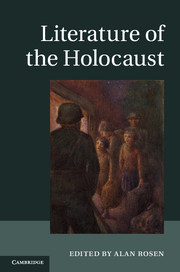Book contents
- Frontmatter
- Contents
- Notes on contributors
- Acknowledgments
- Introduction
- Part I Wartime victim writing
- Part II Postwar responses
- Chapter 3 The Holocaust and Italian literature
- Chapter 4 German literature and the Holocaust
- Chapter 5 Hebrew literature of the Holocaust
- Chapter 6 The Holocaust and postwar Yiddish literature
- Chapter 7 The Holocaust in Russian literature
- Chapter 8 The Holocaust in English-language literatures
- Chapter 9 Polish literature on the Holocaust
- Chapter 10 Hungarian Holocaust literature
- Chapter 11 French literature and the Holocaust
- Part III Other approaches
- Guide to further reading
- Index
- References
Chapter 6 - The Holocaust and postwar Yiddish literature
Published online by Cambridge University Press: 05 June 2014
- Frontmatter
- Contents
- Notes on contributors
- Acknowledgments
- Introduction
- Part I Wartime victim writing
- Part II Postwar responses
- Chapter 3 The Holocaust and Italian literature
- Chapter 4 German literature and the Holocaust
- Chapter 5 Hebrew literature of the Holocaust
- Chapter 6 The Holocaust and postwar Yiddish literature
- Chapter 7 The Holocaust in Russian literature
- Chapter 8 The Holocaust in English-language literatures
- Chapter 9 Polish literature on the Holocaust
- Chapter 10 Hungarian Holocaust literature
- Chapter 11 French literature and the Holocaust
- Part III Other approaches
- Guide to further reading
- Index
- References
Summary
Postwar Yiddish Holocaust literature
“What affects me the most,” laments Chava Rosenfarb, “is the continual sense of isolation that I feel as a survivor – an isolation enhanced by my being a Yiddish writer. I feel myself to be like an anachronism wandering about a page of history on which I don’t belong.” The fate of the Yiddish language is at the crux of this isolation: “If writing is a lonely profession,” continues Rosenfarb, “the Yiddish writer’s loneliness has an additional dimension. His readership has perished. His language has gone up with the smoke of the crematoria. He or she creates in a vacuum, almost without a readership, out of fidelity to a vanished language – as if to prove that Nazism did not succeed in extinguishing that language’s last breath, and that it is still alive.”
Post-1945 Jewish writers, whatever their individual biographies and languages, wrote in the shadow of the Holocaust. Yiddish writers in particular were compelled to bear witness, and to commemorate the destruction of Central and Eastern European Jewry (Ashkenaz), where the majority of Jewish victims had been Yiddish speakers. Yiddish writers’ identification with the kedoyshim (holy martyrs), as the victims of the Holocaust were called, resulted in works of great artistic and emotional power. As a result, testimonies, life writing, chronicles, historical novels, and poetic lamentation (klog lider) came to define the generic map of Yiddish writing after 1945.
- Type
- Chapter
- Information
- Literature of the Holocaust , pp. 102 - 117Publisher: Cambridge University PressPrint publication year: 2013



